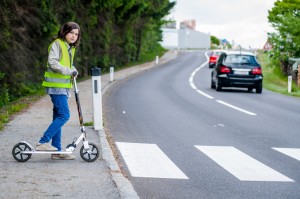Kids and Traffic: Looking Without Seeing
 Getting hit by a car is among the leading causes of death for kids 5- to 9-years-old. It’s not hard to speculate why. Children are easily distracted, and because they’re smaller, they’re more at risk of dying from their injuries.
Getting hit by a car is among the leading causes of death for kids 5- to 9-years-old. It’s not hard to speculate why. Children are easily distracted, and because they’re smaller, they’re more at risk of dying from their injuries.
But recent studies suggest another basic reason that so many young pedestrians die in traffic accidents—they simply don’t see cars coming toward them. London researchers have found that kids’ perceptual and attention abilities are slow to develop, making them less capable of noticing an oncoming car, let alone the vehicle’s proximity and speed.
One of these studies was reported recently in Frontiers of Human Neuroscience. To test peripheral perception across different age groups, psychological scientist Nilli Lavie and colleagues recruited over 200 visitors to the Science Museum in London for an experiment. The participants were asked to judge which line in a cross shape was the longest in seven trials. In the seventh, a black square outline flashed up on the screen and participants were asked whether they noticed it or not. Task difficulty was adjusted by changing the difference in line length, with a smaller difference representing a higher difficulty.
Adults were able to consistently spot the square more than 90% of the time for both moderate and low difficulty tests, whereas children’s performance was far worse. Younger children had significantly lower awareness, with fewer than 10% of 7-10 year olds spotting the squares during the moderate task and only around half spotting them during the easy task. There were no differences between the two difficulties for adults, since both tasks were relatively simple, showing that young children are particularly prone to inattentional blindness.
In a 2010 study, psychological scientist John Wann and his colleagues at the University of London ran a laboratory simulation of regular street crossing in order to compare the perceptual skills of adults with those of children of various ages. In this simulation, a car approached on a roadway, sometimes varying in size and speed; sometimes the subjects saw the car directly in front of them, and other times slightly off to the side, and they reported whether the image of the car expanded or stayed the same. The scientists also calculated the subjects’ walking speed, and factored their movement into a calculation of their perception of the approaching car.
They found a clear developmental pattern in perception of the looming vehicles, according to report in the journal Psychological Science, the kids showed clear improvement in their acuity with age, but even the older children did not match the adults in their ability to detect an automobile’s approach. This suggests that the neural mechanisms for this skill remain undeveloped. Paradoxically, faster moving cars appear to loom less than slow moving cars, creating the illusion that speedy cars are not approaching.
Indeed, the scientists determined that children could not reliably detect a car approaching at speeds faster than 20 miles per hour. What’s more, the kids’ perception of a car’s approach was worse if the car was even slightly off to the side—a realistic condition for typical road crossing—or if they themselves were in motion, as they likely would be.





APS regularly opens certain online articles for discussion on our website. Effective February 2021, you must be a logged-in APS member to post comments. By posting a comment, you agree to our Community Guidelines and the display of your profile information, including your name and affiliation. Any opinions, findings, conclusions, or recommendations present in article comments are those of the writers and do not necessarily reflect the views of APS or the article’s author. For more information, please see our Community Guidelines.
Please login with your APS account to comment.